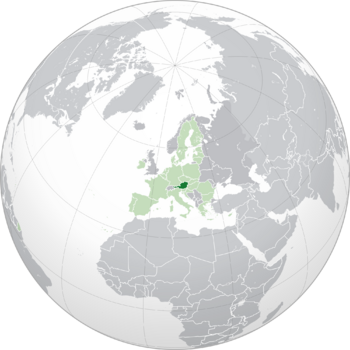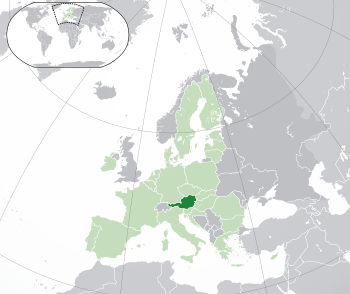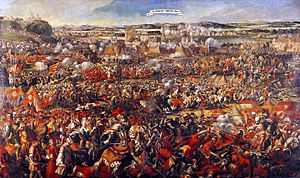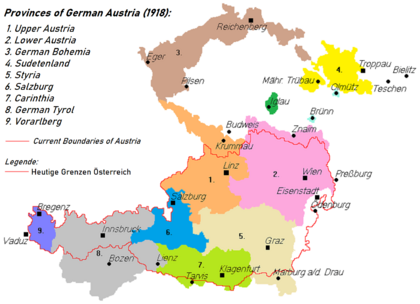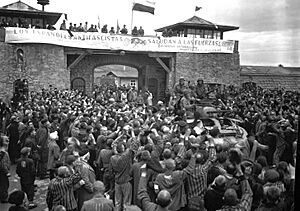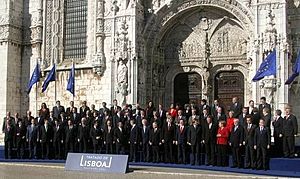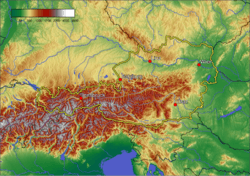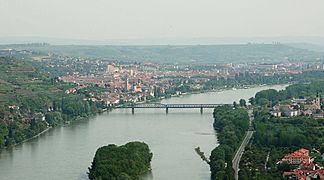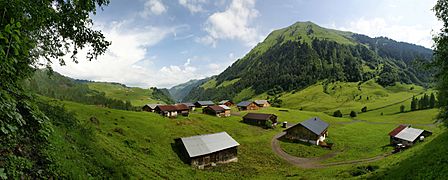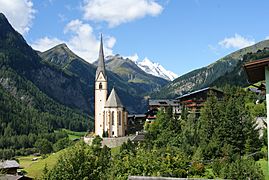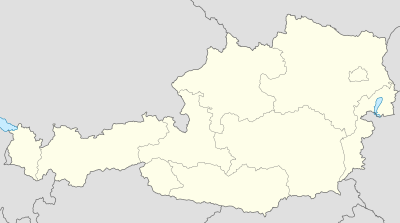Austria facts for kids
Quick facts for kids
Republic of Austria
Republik Österreich (German)
|
|
|---|---|
|
Location of Austria (dark green)
– on the European continent (green & dark grey) |
|
| Capital and largest city
|
Vienna 48°12′N 16°21′E / 48.200°N 16.350°E |
| Official languages | German |
| National language | Austrian German (Austrian) |
| Official regional languages | |
| Ethnic groups
(2023)
|
|
| Religion
(2021)
|
|
| Demonym(s) | Austrian |
| Government | Federal semi-presidential republic |
| Alexander Van der Bellen | |
| Alexander Schallenberg (acting) | |
| Legislature | Parliament |
| Federal Council | |
| National Council | |
| Formation | |
|
• Margraviate
(oldest naming) |
c. 970 (1 November 996) |
|
• Duchy
|
17 September 1156 |
| 6 January 1453 | |
|
• Imperial circle
|
1512 |
|
• Empire
|
11 August 1804 |
| 30 March 1867 | |
| 10 September 1919 | |
|
• Federal State
|
1 May 1934 |
| 13 March 1938 | |
| 27 April 1945 | |
| 27 July 1955 | |
| Area | |
|
• Total
|
83,879 km2 (32,386 sq mi) (113th) |
|
• Water (%)
|
0.84 (2015) |
| Population | |
|
• April 2022 estimate
|
|
|
• Density
|
107.6/km2 (278.7/sq mi) (106th) |
| GDP (PPP) | 2024 estimate |
|
• Total
|
|
|
• Per capita
|
|
| GDP (nominal) | 2024 estimate |
|
• Total
|
|
|
• Per capita
|
|
| Gini (2023) | ▲ 28.1 low |
| HDI (2022) | very high · 22nd |
| Currency | Euro (€) (EUR) |
| Time zone | UTC+1 (CET) |
|
• Summer (DST)
|
UTC+2 (CEST) |
| Calling code | +43 |
| ISO 3166 code | AT |
| Internet TLD | .at |
Austria, formally the Republic of Austria, is a country in Central Europe, lying in the Eastern Alps. It is a federation of nine states, one of which is the capital, Vienna, the most populous city and state. Austria is bordered by Germany to the northwest, the Czech Republic to the north, Slovakia to the northeast, Hungary to the east, Slovenia and Italy to the south, and Switzerland and Liechtenstein to the west. The landlocked country occupies an area of 83,879 km2 (32,386 sq mi) and has a population of around 9 million.
The people in Austria speak German, a few also Hungarian, Slovenian and Croatian. The capital of Austria is Vienna (Wien).
Austria is more than a thousand years old. Its history can be followed to the ninth century. At that time the first people moved to the land now known as Austria. The name "Ostarrichi" is first written in an official document from 996. Since then this word has developed into the Modern German word Österreich, which literally means "East Kingdom."
Austria is a neutral state, that means it does not take part in wars with other countries. Austria has been in the United Nations since 1955 and in the European Union since 1995.
Contents
History
Prehistory and antiquity
The area that is now Austria was settled in pre-Roman times by various Celtic tribes, having been the core of the Hallstatt culture by the 6th century BC. The city of Hallstatt, in fact, has the oldest archaeological evidence of the Celts in Europe.
The Celtic Kingdom of Noricum that included most of modern Austria and parts of modern Slovenia was conquered by the Roman Empire in 16 BC and made a province called Noricum which lasted until 476. The regions of today's Austria which were not located within the province of Noricum were divided between the Roman provinces of Pannonia, which encompassed parts of eastern Austria, and Raetia, which encompassed the areas of present-day Vorarlberg and Tyrol.
Present-day Petronell-Carnuntum in eastern Austria was an important army camp turned capital city in what became known as the Pannonia Superior. Carnuntum was home to 50,000 people for nearly 400 years.
Middle Ages
After the fall of the Roman Empire, the area was first invaded by the Germanic Rugii which made this region part of their "Rugiland". In 487, most of modern Austria was conquered by Odoacer, a barbarian soldier and statesman from the Middle Danube, which incorporated most of today's Austria in his Kingdom of Italy. By 493, it was conquered by the Germanic Ostrogoths which created their own kingdom, the Ostrogothic Kingdom. Following the Kingdom's fall the area was invaded by the Alemanni, Baiuvarii, Slavs, and Avars.
Charlemagne, King of the Franks, conquered the area in 788, encouraged colonisation, and introduced Christianity. As part of Eastern Francia, the core areas that now encompass Austria were bequeathed to the house of Babenberg. The area was known as the marchia Orientalis and was given to Leopold of Babenberg in 976.
The first record showing the name Austria is from 996, where it is written as Ostarrîchi, referring to the territory of the Babenberg March. In 1156, the Privilegium Minus elevated Austria to the status of a duchy. In 1192, the Babenbergs also acquired the Duchy of Styria. With the death of Frederick II in 1246, the line of the Babenbergs was extinguished.
As a result, Ottokar II of Bohemia effectively assumed control of the duchies of Austria, Styria, and Carinthia. His reign came to an end with his defeat at Dürnkrut at the hands of Rudolph I of Germany in 1278. Thereafter, until World War I, Austria's history was largely that of its ruling dynasty, the Habsburgs.
In the 14th and 15th centuries, the Habsburgs began to accumulate other provinces in the vicinity of the Duchy of Austria. In 1438, Duke Albert V of Austria was chosen as the successor to his father-in-law, Emperor Sigismund. Although Albert himself only reigned for a year, henceforth every emperor of the Holy Roman Empire was a Habsburg, with only one exception.
The Habsburgs began also to accumulate territory far from the hereditary lands. In 1477, Archduke Maximilian, only son of Emperor Frederick III, married the heiress Maria of Burgundy, thus acquiring most of the Netherlands for the family. In 1496, his son Philip the Fair married Joanna the Mad, the heiress of Castile and Aragon, thus acquiring Spain and its Italian, African, Asian, and New World appendages for the Habsburgs.
In 1526, following the Battle of Mohács, Bohemia and the part of Hungary not occupied by the Ottomans came under Austrian rule. Ottoman expansion into Hungary led to frequent conflicts between the two empires, particularly evident in the Long War of 1593 to 1606. The Turks made incursions into Styria nearly 20 times, of which some are cited as "burning, pillaging, and taking thousands of slaves". In late September 1529, Suleiman the Magnificent launched the first siege of Vienna, which unsuccessfully ended, according to Ottoman historians, with the snowfalls of an early beginning winter.
17th and 18th centuries
During the long reign of Leopold I, Holy Roman Emperor following the successful defence of Vienna against the Turks in 1683, under the command of the King of Poland John III Sobieski, the Great Turkish War resulted in most of Hungary being controlled by Austria. This arrangement was formalized in the Treaty of Karlowitz in 1699.
Charles VI, Holy Roman Emperor relinquished many of the gains the empire made in the previous years. He enjoyed the imminent extinction of the House of Habsburg. Charles VI was willing to offer concrete advantages in territory and authority in exchange for recognition of the Pragmatic Sanction of 1713. Therefore, his daughter Maria Theresa was recognized as his heir. With the rise of Prussia, the Austria–Prussia rivalry began in Germany. Austria participated, together with Prussia and Russia, in the first and the third of the three Partitions of Poland in 1772 and 1795 respectively.
From that time, Austria became the birthplace of classical music and played host to different composers including Joseph Haydn, Wolfgang Amadeus Mozart, Ludwig van Beethoven, and Franz Schubert.
19th century

Austria later became engaged in a war with Revolutionary France, which was highly unsuccessful in the beginning, with successive defeats at the hands of Napoleon Bonaparte, meaning the end of the old Holy Roman Empire in 1806. Two years earlier, the Empire of Austria was founded. From 1792 to 1801, the Austrians had suffered 754,700 casualties. In 1814, Austria was part of the Allied forces that invaded France and brought to an end the Napoleonic Wars.
It emerged from the Congress of Vienna in 1815 as one of the continent's four dominant powers and a recognised great power. The same year, the German Confederation (Deutscher Bund) was founded under the presidency of Austria. Because of unsolved social, political, and national conflicts, the German lands were shaken by the 1848 revolutions aiming to create a unified Germany.
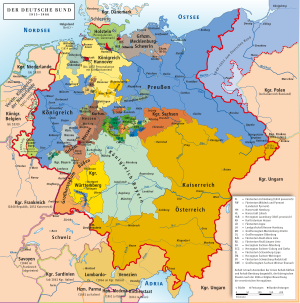
The various different possibilities for a united Germany were: a Greater Germany, or a Greater Austria or just the German Confederation without Austria at all. As Austria was not willing to relinquish its German-speaking territories to what would become the German Empire of 1848, the crown of the newly formed empire was offered to the Prussian King Friedrich Wilhelm IV. In 1864, Austria and Prussia fought together against Denmark and secured the independence from Denmark of the duchies of Schleswig and Holstein. As they could not agree on how the two duchies should be administered, though, they fought the Austro-Prussian War in 1866. Defeated by Prussia in the Battle of Königgrätz, Austria had to leave the German Confederation and no longer took part in German politics.
After the defeated Hungarian Revolution of 1848, the Austro-Hungarian Compromise of 1867, the Ausgleich, provided for a dual sovereignty, the Austrian Empire and the Kingdom of Hungary, under Franz Joseph I. The Austrian-Hungarian rule of this diverse empire included various groups, including Germans, Hungarians, Croats, Czechs, Poles, Rusyns, Serbs, Slovaks, Slovenes, and Ukrainians, as well as large Italian and Romanian communities.
As a result, ruling Austria-Hungary became increasingly difficult in an age of emerging nationalist movements, requiring considerable reliance on an expanded secret police. Yet, the government of Austria tried its best to be accommodating in some respects: for example, the Reichsgesetzblatt, publishing the laws and ordinances of Cisleithania, was issued in eight languages; and all national groups were entitled to schools in their own language and to the use of their mother tongue at state offices.
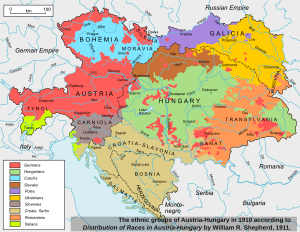
Many Austrian Germans of all different social circles such as Georg Ritter von Schönerer promoted strong pan-Germanism in the hope of reinforcing an ethnic German identity amongst Austrian Germans and the annexation of Austria to Germany (Anschluss). Some Austrians such as Karl Lueger also used pan-Germanism as a form of populism to further their own political goals. Although Bismarck's policies excluded Austria and the German Austrians from Germany, many Austrian pan-Germans idolised him and wore blue cornflowers, known to be the favourite flower of German Emperor William I, in their buttonholes, along with cockades in the German national colours (black, red, and yellow), although they were both temporarily banned in Austrian schools, as a way to show discontent towards the multi-ethnic empire.
Austria's exclusion from Germany caused many Austrians a problem with their national identity and prompted the Social Democratic Leader Otto Bauer to state that it was "the conflict between our Austrian and German character". The Austro-Hungarian Empire caused ethnic tension between the German Austrians and the other ethnic groups. Many Austrians, especially those involved with the pan-German movements, desired a reinforcement of an ethnic German identity and hoped that the empire would collapse, which would allow an annexation of Austria by Germany.
A lot of Austrian pan-German nationalists protested passionately against minister-president Kasimir Count Badeni's language decree of 1897, which made German and Czech co-official languages in Bohemia and required new government officials to be fluent in both languages. This meant in practice that the civil service would almost exclusively hire Czechs because most middle-class Czechs spoke German but not the other way around. The support of ultramontane Catholic politicians and clergy for this reform triggered the launch of the Away from Rome movement, which was initiated by supporters of Schönerer and called on "German" Christians to leave the Roman Catholic Church.
Early 20th century
As the Second Constitutional Era began in the Ottoman Empire, Austria-Hungary took the opportunity to annex Bosnia and Herzegovina in 1908. The assassination of Archduke Franz Ferdinand in Sarajevo in 1914 by Bosnian Serb Gavrilo Princip was used by leading Austrian politicians and generals to persuade the emperor to declare war on Serbia, thereby risking and prompting the outbreak of World War I, which eventually led to the dissolution of the Austro-Hungarian Empire. Over one million Austro-Hungarian soldiers died in World War I.
On 21 October 1918, the elected German members of the Reichsrat (parliament of Imperial Austria) met in Vienna as the Provisional National Assembly for German Austria (Provisorische Nationalversammlung für Deutschösterreich). On 30 October the assembly founded the Republic of German-Austria by appointing a government, called Staatsrat. This new government was invited by the Emperor to take part in the decision on the planned armistice with Italy but refrained from this business.
This left the responsibility for the end of the war, on 3 November 1918, solely to the emperor and his government. On 11 November, the emperor, advised by ministers of the old and the new governments, declared he would not take part in state business any more; on 12 November, German-Austria, by law, declared itself to be a democratic republic and part of the new German republic. The constitution, renaming the Staatsrat as Bundesregierung (federal government) and Nationalversammlung as Nationalrat (national council) was passed on 10 November 1920.
The Treaty of Saint-Germain of 1919 (for Hungary the Treaty of Trianon of 1920) confirmed and consolidated the new order of Central Europe which to a great extent had been established in November 1918, creating new states and altering others. The German-speaking parts of Austria which had been part of Austria-Hungary were reduced to a rump state named the Republic of German-Austria (German: Republik Deutschösterreich), though excluding the predominantly German-speaking South Tyrol. The desire for the annexation of Austria to Germany was a popular opinion shared by all social circles in both Austria and Germany. On 12 November, German-Austria was declared a republic, and named Social Democrat Karl Renner as provisional chancellor. On the same day it drafted a provisional constitution that stated that "German-Austria is a democratic republic" (Article 1) and "German-Austria is an integral part of the German reich" (Article 2). The Treaty of Saint Germain and the Treaty of Versailles explicitly forbade union between Austria and Germany. The treaties also forced German-Austria to rename itself as "Republic of Austria" which consequently led to the first Austrian Republic.
Over three million German-speaking Austrians found themselves living outside the new Austrian Republic as minorities in the newly formed or enlarged states of Czechoslovakia, Yugoslavia, Hungary, and Italy. These included the provinces of South Tyrol, and German Bohemia. The status of German Bohemia and Sudetenland later played a role in World War II.
The border between Austria and the Kingdom of Yugoslavia was settled with the Carinthian Plebiscite in October 1920 and allocated the major part of the territory of the former Austro-Hungarian Crownland of Carinthia to Austria. This set the border on the Karawanks mountain range, with many Slovenes remaining in Austria.
Interwar period and World War II
After the war, inflation began to devalue the Krone, which was still Austria's currency. In the autumn of 1922, Austria was granted an international loan supervised by the League of Nations. The purpose of the loan was to avert bankruptcy, stabilise the currency, and improve Austria's general economic condition. The loan meant that Austria passed from an independent state to the control exercised by the League of Nations. In 1925, the Austrian schilling was introduced, replacing the Krone at a rate of 10,000:1. Later, it was nicknamed the "Alpine dollar" due to its stability. From 1925 to 1929 the economy enjoyed a short high before nearly crashing after Black Tuesday.
The First Austrian Republic lasted until 1933, when Chancellor Engelbert Dollfuss, using what he called "self-switch-off of Parliament", established an autocratic regime tending towards Italian fascism. The two big parties at this time, the Social Democrats and the Conservatives, had paramilitary armies; the Social Democrats' Republikanischer Schutzbund was now declared illegal, but was still operative as the 12–15 February 1934 Austrian Civil War broke out.
In February 1934, several members of the Schutzbund were executed, the Social Democratic party was outlawed, and many of its members were imprisoned or emigrated. On 1 May 1934, the Austrofascists imposed a new constitution ("Maiverfassung") which cemented Dollfuss's power, but on 25 July he was assassinated in an Austrian Nazi coup attempt.

His successor Kurt Schuschnigg acknowledged the fact that Austria was a "German state" and he also believed that Austrians were "better Germans" but he wished that Austria would remain independent. He announced a referendum on 9 March 1938, to be held on 13 March, concerning Austria's independence from Germany.
Nazi rule
On 12 March 1938, Austrian Nazis took over the government, while German troops occupied the country, which prevented Schuschnigg's referendum from taking place. On 13 March 1938, the Anschluss (lit. joining – lit. connection) of Austria was officially declared. Two days later, Austrian-born Adolf Hitler announced what he called the "reunification" of his home country with the "rest of the German Reich" on Vienna's Heldenplatz. He established a referendum which confirmed the union with Germany in April 1938.
Parliamentary elections were held in Germany (including recently annexed Austria) on 10 April 1938. They were the final elections to the Reichstag during Nazi rule, and they took the form of a single-question referendum asking whether voters approved of a single Nazi-party list for the 813-member Reichstag, as well as the recent annexation of Austria (the Anschluss). Jews, Roma and Sinti were not allowed to vote. Turnout in the election was officially 99.5%, with 98.9% voting "yes". In the case of Austria, Adolf Hitler's native soil, 99.71% of an electorate of 4,484,475 officially went to the ballots, with a positive tally of 99.73 percent. Although most Austrians favoured the Anschluss, in certain parts of Austria, the German soldiers were not always welcomed with flowers and joy, especially in Vienna, which had Austria's largest Jewish population. Nevertheless, despite the propaganda and the manipulation and rigging which surrounded the ballot box result, there was massive genuine support for Hitler for fulfilling the Anschluss, since many Germans from both Austria and Germany saw it as completing the long overdue unification of all Germans into one state.
On 13 March 1938, Austria was annexed by the Third Reich and ceased to exist as an independent country (the Anschluss). The Aryanisation of the wealth of Jewish Austrians started immediately in mid-March, with a so-called "wild" (i.e. extra-legal) phase, but it was soon structured legally and bureaucratically so the assets which Jewish citizens possessed could be stripped from them. At that time, Adolf Eichmann, who grew up in Austria, was transferred to Vienna and ordered to persecute the Jews. During the November pogrom in 1938 ("Reichskristallnacht"), Jews and Jewish institutions such as synagogues were subjected to violent attacks in Vienna, Klagenfurt, Linz, Graz, Salzburg, Innsbruck and several cities in Lower Austria. Otto von Habsburg, a vehement opponent of the Nazis, the last Crown Prince of Austria-Hungary, an honorary citizen of hundreds of places in Austria and partly envisaged by Schuschnigg as a monarchical option, was in Belgium at the time. He spoke out against the Anschluss and was then wanted by the Nazi regime and his property would have been expropriated and he would have been shot immediately if he were caught. In 1938, the Nazis renamed Austria the "Ostmark", a name which it had until 1942, when it was renamed the "Alpine and Danubian Gaue" (Alpen-und Donau-Reichsgaue).
Though Austrians made up only 8% of the population of the Third Reich, some of the most prominent Nazis were native Austrians, including Adolf Hitler, Ernst Kaltenbrunner, Arthur Seyss-Inquart, Franz Stangl, Alois Brunner, Friedrich Rainer, and Odilo Globocnik, as were over 13% of the members of the SS and 40% of the staff at the Nazi extermination camps. In the Reichsgau, besides the main camp KZ-Mauthausen, there were numerous sub-camps in all provinces where Jews and other prisoners were killed, tortured and exploited. At this time, because the territory was outside the operational radius of Allied aircraft, the armaments industry was greatly expanded through the forced labour of concentration camp prisoners, this was especially the case with regard to the manufacture of fighter planes, tanks and missiles.
Most of the resistance groups were soon crushed by the Gestapo. While the plans of the group around Karl Burian to blow up the Gestapo's headquarters in Vienna were uncovered, the important group around the later executed priest Heinrich Maier managed to contact the Allies. This so-called Maier-Messner group was able to send the Allies information about armaments factories where V-1 flying bombs, V-2 rockets, Tiger tanks, and aircraft (Messerschmitt Bf 109, Messerschmitt Me 163 Komet, etc.) were manufactured, information which was important to the success of Operation Crossbow and Operation Hydra, both of which were preliminary missions before the launch of Operation Overlord. This resistance group, which was in contact with the American secret service (OSS), soon provided information about mass executions and concentration camps such as Auschwitz. The group's aim was to cause Nazi Germany to lose the war as quickly as possible and re-establish an independent Austria.
Allied occupation
Vienna fell on 13 April 1945, during the Soviet Vienna offensive, just before the total collapse of the Third Reich. The invading Allied powers, in particular the Americans, planned for the supposed "Alpine Fortress Operation" of a national redoubt, that was largely to have taken place on Austrian soil in the mountains of the Eastern Alps. However, it never materialised because of the rapid collapse of the Reich.
Karl Renner and Adolf Schärf (Socialist Party of Austria [Social Democrats and Revolutionary Socialists]), Leopold Kunschak (Austria's People's Party [former Christian Social People's Party]), and Johann Koplenig (Communist Party of Austria) declared Austria's secession from the Third Reich by the Declaration of Independence on 27 April 1945 and set up a provisional government in Vienna under state Chancellor Renner the same day, with the approval of the victorious Red Army and backed by Joseph Stalin. (The date is officially named the birthday of the second republic.) At the end of April, most of western and southern Austria were still under Nazi rule. On 1 May 1945, the Federal Constitutional Law of 1920, which had been terminated by dictator Dollfuss on 1 May 1934, was declared valid again. The total number of Austrian military deaths from 1939 to 1945 was 260,000. The total number of Jewish Austrian Holocaust victims was 65,000. About 140,000 Jewish Austrians had fled from the country in 1938–39. Thousands of Austrians had taken part in serious Nazi crimes (hundreds of thousands of people died in the Mauthausen-Gusen concentration camp alone), a fact which was officially acknowledged by Chancellor Franz Vranitzky in 1992.
Allied-occupied Austria was after World War II divided into military occupation zones. Austria was governed by the Allied Commission for Austria. As stipulated in the Moscow Declaration of 1943 a subtle difference was seen in the treatment of Austria by the Allies.
The Austrian government, consisting of Social Democrats, Conservatives, and Communists resided in Vienna, which was surrounded by the Soviet zone. This Austrian government was recognised by the allies of World War II in October 1945 despite concerns that Karl Renner could be Stalin's puppet. On 26 July 1946 the Austrian Parliament passed its first nationalization law and approximately 70 mining and manufacturing companies were seized by the Austrian state. The Ministry of Property Protection and Economic Planning (Ministerium für Vermögenssicherung und Wirtschaftsplanung) was responsible for directing the nationalized industries under the directorship of Minister Peter Krauland (party ÖVP).
Independence
On 15 May 1955, after talks which lasted for years and were influenced by the Cold War Austria regained full independence by concluding the Austrian State Treaty with the allies of World War II. On 26 October 1955, all occupation troops had left and Austria declared its permanent neutrality by an act of parliament. This day is now Austria's National Day, a public holiday.
The status of Tyrol was a lingering problem between Austria and Italy. To this day, there are 20 different squares in Austrian cities called "Südtiroler Platz" (South Tyrolean Square) in memory of the supposed loss of the Austrian territories. Terrorist acts by the South Tyrolean independence movement have been documented in the 1950s and 1960s. A great degree of autonomy was granted to Tyrol by the Italian national government.
The political system of the Second Republic is based on the constitution of 1920 and 1929, which was reintroduced in 1945. The system came to be characterised by Proporz, whereby most posts of political importance were split proportionately between members of the Social Democratic Party of Austria (SPÖ) and the Austrian People's Party (ÖVP). Interest group "chambers" with mandatory membership (e.g. for workers, business people, farmers) grew to considerable importance and were usually consulted in the legislative process, so hardly any legislation was passed that did not reflect widespread consensus.
Since 1945, governing via a single-party government has occurred twice: 1966–1970 (ÖVP) and 1970–1983 (SPÖ). During all other legislative periods, either a grand coalition of SPÖ and ÖVP or a "small coalition" (one of these two and a smaller party) ruled the country.
Kurt Waldheim, the former secretary-general of the United Nations, was elected President of Austria from 1986 to 1992. He had been a Wehrmacht officer in the Second World War and was accused of war crimes.
Following a referendum in 1994, at which consent reached a majority of two-thirds, the country became a member of the European Union on 1 January 1995.
The major parties SPÖ and ÖVP have contrary opinions about the future status of Austria's military nonalignment: While the SPÖ in public supports a neutral role, the ÖVP argues for stronger integration into the EU's security policy; even a future NATO membership is not ruled out by some ÖVP politicians (ex. Werner Fasslabend (ÖVP) in 1997). In reality, Austria is taking part in the EU's Common Foreign and Security Policy, participates in peacekeeping and peace creating tasks, and has become a member of NATO's "Partnership for Peace"; the constitution has been amended accordingly. Since Liechtenstein joined the Schengen Area in 2011, none of Austria's neighbouring countries performs border controls towards it anymore.
Government and politics
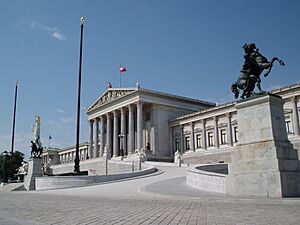
The Parliament of Austria is located in Vienna, the country's capital and most populous city. Austria became a federal, representative democratic republic through the Federal Constitutional Law of 1920. The political system of the Second Republic with its nine federal states is based on the constitution of 1920, amended in 1929, which was re-enacted on 1 May 1945.
The president of Austria is the head of state. The president is directly elected by popular majority vote, with a run-off between the top-scoring candidates if necessary. The chancellor of Austria is head of the government. The chancellor is selected by the president and tasked with forming a government based on the partisan composition of the lower house of parliament.
The government can be removed from office by either a presidential decree or by vote of no confidence in the lower chamber of parliament, the Nationalrat. Voting for the president and for the parliament used to be compulsory in Austria. The compulsion was abolished in steps from 1982 to 2004.
Austria's parliament consists of two chambers. The composition of the Nationalrat (183 seats) is determined every five years (or whenever the Nationalrat has been dissolved by the federal president on a motion by the federal chancellor, or by the Nationalrat itself) by a general election in which every citizen over the age of 16 has the right to vote. The voting age was lowered from 18 in 2007.
While the bicameral Parliament and the Government constitute the legislative and executive branches, respectively, the courts are the third branch of Austrian state powers. The Constitutional Court (Verfassungsgerichtshof) exerts considerable influence on the political system because of its power to invalidate legislation and ordinances that are not in compliance with the Constitution. Since 1995, the European Court of Justice may overrule Austrian decisions in all matters defined in the laws of the European Union. Austria also implements the decisions of the European Court of Human Rights, since the European Convention on Human Rights is part of the Austrian constitution.
Geography
Austria is a largely mountainous country due to its location in the Alps. The Central Eastern Alps, Northern Limestone Alps and Southern Limestone Alps are all partly in Austria. Of the total area of Austria (84,000 km2 or 32,433 sq mi), only about a quarter can be considered low lying, and only 32% of the country is below 500 metres (1,640 ft). The Alps of western Austria give way somewhat into low lands and plains in the eastern part of the country.
Austria lies between latitudes 46° and 49° N, and longitudes 9° and 18° E.
It can be divided into five areas, the biggest being the Eastern Alps, which constitute 62% of the nation's total area. The Austrian foothills at the base of the Alps and the Carpathians account for around 12% and the foothills in the east and areas surrounding the periphery of the Pannoni low country amount to about 12% of the total landmass. The second greater mountain area (much lower than the Alps) is situated in the north. Known as the Austrian granite plateau, it is located in the central area of the Bohemian Mass and accounts for 10% of Austria. The Austrian portion of the Vienna basin comprises the remaining 4%.
The six highest mountains in Austria are:
| Name | Height | Range | |
|---|---|---|---|
| 1 | Großglockner | 3,798 m | High Tauern |
| 2 | Wildspitze | 3,772 m | Ötztal Alps |
| 3 | Kleinglockner | 3,770 m | High Tauern |
| 4 | Weißkugel | 3,739 m | Ötztal Alps |
| 5 | Pöschlturm | 3,721 m | High Tauern |
| 6 | Hörtnagelturm | 3,719 m | High Tauern |
Phytogeographically, Austria belongs to the Central European province of the Circumboreal Region within the Boreal Kingdom. According to the WWF, the territory of Austria can be subdivided into four ecoregions: the Central European mixed forests, Pannonian mixed forests, Alps conifer and mixed forests and Western European broadleaf forests.
-
View of Hallstatt
-
View of Krems at the end of Wachau valley
-
Austrian rural area of Schoppernau in summer
Climate
The greater part of Austria lies in the cool/temperate climate zone, where humid westerly winds predominate. With nearly three-quarters of the country dominated by the Alps, the alpine climate is predominant. In the east—in the Pannonian Plain and along the Danube valley—the climate shows continental features with less rain than the alpine areas. Although Austria is cold in the winter (−10 to 0 °C), summer temperatures can be relatively high, with average temperatures in the mid-20s and a highest temperature of 40.5 °C (105 °F) in August 2013.
Administrative divisions
Austria is a federal republic consisting of nine federal states (Austrian German: Bundesländer). The federal states are sub-divided into districts (Bezirke) and statutory cities (Statutarstädte). Districts are subdivided into municipalities (Gemeinden). Statutory Cities have the competencies otherwise granted to both districts and municipalities. Vienna is unique in that it is both a city and a federal state. The European Commission's Directorate-General for Translation calls the federal states provinces.
| Federal state | Capital | Area (sq km) |
Population (1 Jan 2017) |
Density per km2 |
GDP (billion euros) (2022 Eurostat) |
GDP per capita |
|---|---|---|---|---|---|---|
| Eisenstadt | 3,965 | 291,942 | 73.6 | 10.454 | 34,900 | |
| Klagenfurt | 9,536 | 561,077 | 58.8 | 24.755 | 43,600 | |
| Sankt Pölten | 19,178 | 1,665,753 | 86.9 | 71.757 | 41,900 | |
| Salzburg | 7,154 | 549,263 | 76.8 | 33.330 | 58,900 | |
| Graz | 16,401 | 1,237,298 | 75.4 | 56.152 | 44,600 | |
| Innsbruck | 12,648 | 746,153 | 59.0 | 39.328 | 51,200 | |
| Linz | 11,982 | 1,465,045 | 122.3 | 76.780 | 50,700 | |
| 415 | 1,867,582 | 4,500 | 110.992 | 56,600 | ||
| Bregenz | 2,601 | 388,752 | 149.5 | 23.588 | 58,300 | |
Economy
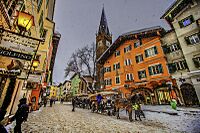
Austria has highly industrialised economy. Next to a highly developed industry, international tourism is the most important part of the economy of Austria.
Germany has historically been the main trading partner of Austria.
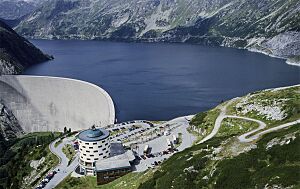
Austria currently produces more than half of its electricity by hydropower. Together with other renewable energy sources such as wind power, solar power, and biomass, the electricity supply from renewable energy amounts to 62.89 percent.
Rail transport in Austria is primarily provided by the national carrier Austrian Federal Railways (Österreichische Bundesbahnen, ÖBB). It operates most commuter rail systems and long-distance trains.
Demographics
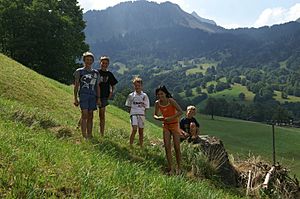
Austria's population was estimated to be 8.72 million in April 2016 by the Statistik Austria. The population of the capital, Vienna, exceeds 1.8 million (2.6 million, including the suburbs), representing about a quarter of the country's population. It is known for its cultural offerings and high standard of living.
Vienna is by far the country's largest city. Graz is second in size, with 265,778 inhabitants, followed by Linz (191,501), Salzburg (145,871), and Innsbruck (122,458). All other cities have fewer than 100,000 inhabitants.
According to Eurostat, in 2010 there were 1.27 million foreign-born residents in Austria, corresponding to 15.2% of the total population. Of these, 764,000 (9.1%) were born outside the EU and 512,000 (6.1%) were born in another EU Member State.
185,592 Turks (including a minority of Turkish Kurds) make up the second biggest single ethnic minority in Austria after Germans (2.5%), representing 2.2% of the total population. 13,000 Turks were naturalised in 2003 and an unknown number have arrived in Austria at the same time. While 2,000 Turks left Austria in the same year, 10,000 immigrated to the country, confirming a strong trend of growth. Together, Serbs, Croats, Bosniaks and Slovenes make up about 5.1% of Austria's total population.
Culture
Music and Arts
Many famous composers were Austrians or born in Austria. There are Wolfgang Amadeus Mozart, Joseph Haydn, Franz Schubert, Anton Bruckner, Johann Strauss, Sr., Johann Strauss, Jr. and Gustav Mahler. In modern times there were Arnold Schoenberg, Anton Webern and Alban Berg, who belonged to the Second Viennese School.
Austria has many artists, there are Gustav Klimt, Oskar Kokoschka, Egon Schiele or Friedensreich Hundertwasser, Inge Morath or Otto Wagner and scienc.
Food
Austria's cuisine is derived from that of the Austro-Hungarian Empire. Austrian cuisine is mainly the tradition of Royal-Cuisine ("Hofküche") delivered over centuries. It is famous for its well-balanced variations of beef and pork and countless variations of vegetables. There is also the "Mehlspeisen" Bakery, which created particular delicacies such as Sachertorte, "Krapfen" which are doughnuts usually filled with apricot jam or custard, and "Strudel" such as "Apfelstrudel" filled with apple, "Topfenstrudel" filled with a type of cheese curd called "topfen", and "Millirahmstrudel" (milk-cream strudel).
In addition to native regional traditions, the cuisine has been influenced by Hungarian, Bohemia Czech, Jewish, Italian, Balkan and French cuisine, from which both dishes and methods of food preparation have often been borrowed. The Austrian cuisine is therefore one of the most multicultural and transcultural in Europe.
Typical Austrian dishes include Wiener Schnitzel, Schweinsbraten, Kaiserschmarren, Knödel, Sachertorte and Tafelspitz. There are also Kärntner Kasnudeln, which are pockets of dough filled with Topfen, potatoes, herbs and peppermint which are boiled and served with a butter sauce. Kasnudeln are traditionally served with a salad. Eierschwammerl dishes are also popular. The sugar block dispenser Pez was invented in Austria, as well as Mannerschnitten. Austria is also famous for its Mozartkugeln and its coffee tradition.
Beer is sold in 0.2 litre (a Pfiff), 0.3 litre (a Seidel, kleines Bier or Glas Bier) and 0.5 litre (a Krügerl or großes Bier or Halbe) measures. At festivals one litre Maß and two litre Doppelmaß in the Bavarian style are also dispensed. The most popular types of beer are lager (known as Märzen in Austria), naturally cloudy Zwicklbier and wheat beer. At holidays like Christmas and Easter bock beer is also available.
The most important wine-producing areas are in Lower Austria, Burgenland, Styria and Vienna. The Grüner Veltliner grape provides some of Austria's most notable white wines and Zweigelt is the most widely planted red wine grape.
In Upper Austria, Lower Austria, Styria and Carinthia, Most, a type of cider or perry is widely produced.
Schnapps of typically up to 60% alcohol or fruit brandy is drunk, which in Austria is made from a variety of fruits, for example apricots and rowanberries. The produce of small private schnapps distilleries, of which there are around 20,000 in Austria, is known as Selbstgebrannter or Hausbrand.
Local soft drinks such as Almdudler are very popular around the country as an alternative to alcoholic beverages. Another popular drink is the so-called "Spetzi", a mix between Coca-Cola and the original formula of Orange Fanta or the more locally renowned Frucade. Red Bull, the highest-selling energy drink in the world, was invented in Austria.
UNESCO World Heritage Sites in Austria
- Historic Centre of Salzburg — 1996
- Schönbrunn Palace — 1996
- Hallstatt–Dachstein Salzkammergut Cultural Landscape — 1997
- Semmering Railway — 1998
- Historic Centre of Graz and Schloss Eggenberg — 1999 (extended in 2010)
- Wachau Cultural Landscape — 2000
- Historic Centre of Vienna — 2001
- Lake Neusiedl — 2001
Gallery
Related pages
Images for kids
-
Bilingual sign of Oberwart (in Hungarian Felsőőr) in Burgenland
-
The campus of JKU University of Linz
-
Wolfgang Amadeus Mozart (1756–1791)
-
Arnold Schwarzenegger is a well-known Austrian and American actor.
-
Innsbruck hosted the 1964 and 1976 Winter Olympics, as well as the 2012 Winter Youth Olympics, the first in history.
-
Ski racer Franz Klammer won a gold medal at the 1976 Winter Olympics in Innsbruck.
See also
 In Spanish: Austria para niños
In Spanish: Austria para niños




